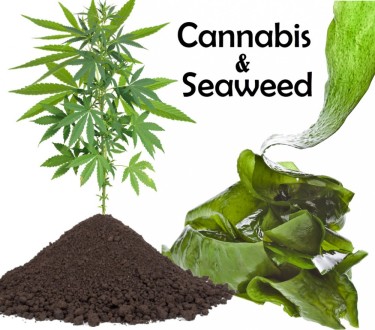
Algae fertilizer for cannabis plants?
Algae: A powerful superfood fertilizer for marijuana plants
Seaweed is one of the healthiest and tastiest ingredients used in cuisines around the world.
It is a powerful source of many nutrients for us: iodine, B vitamins, vitamin K, iron, zinc and even antioxidants – all of which offer tremendous health benefits for us.
But did you know that algae is also a powerful superfood for your marijuana plants?
In fact, algae have been used for agricultural purposes for centuries. Since ancient times, people have used algae to fertilize soil and even make barren soil fertile. Research into the use of seaweed (as well as kelp) has boomed in modern times, proving the effectiveness and usefulness of this humble weed in boosting the growth of many crops, including marijuana.
What is kelp and seaweed?
Algae, also known as macroalgae or seaweed, is an umbrella term that refers to the thousands of plant species that grow in water. They are found in various bodies of water, including the ocean, lakes, and even rivers. Some species are microscopic and therefore cannot be seen by the human eye, but they still serve an important purpose in marine ecosystems by supporting the food chain.
Kelp is a popular type of seaweed. It is a large species of algae that commonly grows in marine forests. Many algae fertilizers are made from kelp or a combination of other algae.
Algae do not contain internal vessels that transport nutrients around them. Because of this, they can ingest anything right out of the water, which is why they need to stay in the water to survive.
Benefits of using seaweed fertilizers
While there are many proven methods for growing healthy marijuana plants, adding algae fertilizer to the mix can make them even better. It’s certainly a much better alternative to traditional fertilizers and can help your plants thrive despite being exposed to environmental stresses such as disease, pests, salinity and drought.
Algae are considered a biostimulant for cannabis and other plants. Biostimulants refer to natural products, not limited to fertilizers, that can promote the growth of plants when given in small amounts. Biostimulants have been used in agriculture to support responsible and sustainable agriculture.
Here’s why you should add algae as a superfood fertilizer for your cannabis plants:
-
Excellent nutrition: When algae grow in water bodies, they take up many macronutrients, micronutrients and minerals, which they pass on to the plants. No other fertilizer can match the nutritional profile of seaweed!
In addition to the above nutrients, it also contains potassium, calcium, magnesium, boron, phytohormones and fatty acids. When marijuana plants absorb these through the fertilizer used, they get a serious nutritional boost that helps them grow and tolerate stress efficiently.
-
Improves Moisture: Adding dry algae to cannabis topsoil in the same manner as mulching is an effective method of locking in moisture in the soil. As a result, you need less watering, but you can rest assured that the cannabis roots will thrive.
-
Germination: Applying seaweed to marijuana plants promotes seed germination while also helping to regulate soil pH. In addition, it improves marijuana metabolism as it increases trace minerals in the soil, allowing the plants and roots to easily absorb the nutrients.
-
Fights Bacteria: Using seaweed fertilizer provides an excellent defense against microbes such as bacteria, parasites and fungi. All of this is detrimental to the growth of any plant, including cannabis, so you want to keep them away as much as possible while stimulating the growth of healthy bacteria in the soil.
How to use algae as cannabis fertilizer
There are already many different types of algae fertilizers on the market:
-
Liquid: Liquid seaweed extracts will likely need to be diluted, but to be sure check the manufacturer’s guidelines. The dilution ratio varies from one product to another, although it’s always best to check because you don’t want to risk overfeeding marijuana plants. Underfeeding is less risky than overfeeding.
-
Powder: There are numerous benefits to feeding your plants a seaweed foliar spray. Just add about ½ teaspoon of powder per 5 liters of water. You only need a small amount to feed the cannabis leaves.
-
Flour: Seaweed flour is best added directly to the soil four months before planting the seedlings. Doing this in advance gives the soil enough time to break down the nutrients so the soil can absorb them efficiently. The typical volume for seaweed meal is about 0.5 kg / 9 cubic meters.
Below are ways you can use fertilizer to enhance cannabis plant growth:
-
Use algae to feed the roots of cannabis plants at all stages of their life cycle;
-
Soak seeds and cuttings in a solution of algae;
-
Add seaweed flour to the root zone;
-
Mist the leaves with seaweed extract—but this is especially helpful when the plants start flowering. This should also be done at the beginning of the light-on cycle;
-
Adding liquid extract or whole seaweed to compost along with other organic feeds;
Conclusion
Algae and kelp are wonderful organic fertilizers for all plants, including marijuana. Experienced cannabis growers know that algae is perhaps the best way to increase plant growth and improve marijuana plant health. Why not try today?
ALGAE FOR WEED PLANTS, READ MORE…

ALGAE ATTACHES TO CANNABIS GROWERS, READ THIS!

Post a comment: